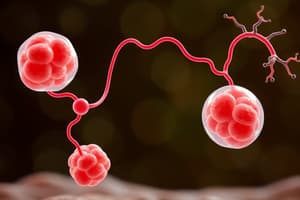Podcast
Questions and Answers
Kāda ir fosforilgrupas loma enerģijas metabolismā?
Kāda ir fosforilgrupas loma enerģijas metabolismā?
- Tā stimulē glikozes ražošanu.
- Tā inhibē ATP sintēzi.
- Tā nodrošina makroergiskos savienojumus. (correct)
- Tā samazina NADPH ražošanu.
Kurei vielai ir loma oxidatīvā fosforilēšanā?
Kurei vielai ir loma oxidatīvā fosforilēšanā?
- NADH (correct)
- ATP
- ADP
- NADP+
Kas notiek ar ATP līmeni, kad tiek palielināta glikozes koncentrācija?
Kas notiek ar ATP līmeni, kad tiek palielināta glikozes koncentrācija?
- ATP tiek uzkrāts muskuļos.
- ATP līmenis samazinās.
- ATP līmenis palielinās. (correct)
- ATP līmenis paliek nemainīgs.
Kāda ir NADPH loma bioloģiskajās reakcijās?
Kāda ir NADPH loma bioloģiskajās reakcijās?
Kāds ir piruvāta loma anaerobās elpošanas procesā?
Kāds ir piruvāta loma anaerobās elpošanas procesā?
Kāds ir vissvarīgākais līdzeklis insulīna ietekmē glikozes metabolismā?
Kāds ir vissvarīgākais līdzeklis insulīna ietekmē glikozes metabolismā?
Kādā veidā ATP ietekmē citrāta sintēzi?
Kādā veidā ATP ietekmē citrāta sintēzi?
Kura no šīm vielām ir fermentu inhibitori glikozes metabolismā?
Kura no šīm vielām ir fermentu inhibitori glikozes metabolismā?
Kurus reaktānus izmanto glikozes sintēzē no piruvāta?
Kurus reaktānus izmanto glikozes sintēzē no piruvāta?
Kāda ir loma glikoneoģenēzē?
Kāda ir loma glikoneoģenēzē?
Kāda ir anaerobās glikolīzes galvenā produkta?
Kāda ir anaerobās glikolīzes galvenā produkta?
Kādām vielām ir loma ribozu sintēzē?
Kādām vielām ir loma ribozu sintēzē?
Kas ir glikozes degradujošs process, kas veicina olbaltumvielu ražošanu?
Kas ir glikozes degradujošs process, kas veicina olbaltumvielu ražošanu?
Kura viela piedalās kā koenzīms Krebs ciklā?
Kura viela piedalās kā koenzīms Krebs ciklā?
Flashcards
Fosforilgrupa
Fosforilgrupa
Fosforilgrupa ir fosfoesteru grupas, kas pievienojas molekulām, lai aktivizētu enerģijas ražošanu.
Fosforilācija
Fosforilācija
Fosforilācija ir process, kurā fosforilgrupa tiek pievienota molekulai, izmainot tās funkciju.
ATP
ATP
ATP ir adenozīna trifosfāts, šūnu galvenais enerģijas avots.
Dihidroksetonu fosfāts
Dihidroksetonu fosfāts
Signup and view all the flashcards
Glikolīze
Glikolīze
Signup and view all the flashcards
Aerobā respirācija
Aerobā respirācija
Signup and view all the flashcards
Anaerobā respirācija
Anaerobā respirācija
Signup and view all the flashcards
NADH
NADH
Signup and view all the flashcards
Krebsa cikls
Krebsa cikls
Signup and view all the flashcards
Glikogēns
Glikogēns
Signup and view all the flashcards
Insulīns
Insulīns
Signup and view all the flashcards
Enerģijas metabolismi
Enerģijas metabolismi
Signup and view all the flashcards
Reaģenti
Reaģenti
Signup and view all the flashcards
Hormonālās regulācijas
Hormonālās regulācijas
Signup and view all the flashcards
Oksidatīvā fosforilācija
Oksidatīvā fosforilācija
Signup and view all the flashcards
Study Notes
Glycolysis Summary
- Glycolysis is the anaerobic oxidation of glucose, occurring in all tissues when oxygen is limited (anaerobic conditions).
- It is the sole energy source for cells without mitochondria.
- The process takes place in the cytoplasm.
Aerobic Conditions
- The reaction involves 10 steps.
- Results in 2 pyruvate molecules, 4 ATP molecules, and 2 NADH molecules (if sufficient oxygen for the Krebs cycle).
Anaerobic Conditions
- The reaction involves 11 steps.
- Results in 2 lactate (lactic acid) molecules and 2 ATP molecules (when oxygen is limited).
- If oxygen supply is restored, lactate is oxidized into pyruvate and enters the Krebs cycle.
Glycolysis Steps (Phase 1 - Preparatory Phase)
- Steps 1 through 5 utilize 2 ATP, and produce 2 identical triose phosphate molecules.
Glycolysis Steps (Phase 2 - Energy Payoff Phase)
- Steps 6 through 10 produce 4 ATP and 2 NADH from 2 triose phosphates, resulting in 2 pyruvate molecules.
Fermentation (Anaerobic)
- Yeast and some microorganisms can convert glucose to ethanol and CO2.
- Humans and other higher organisms do not use fermentation to process glucose.
Phosphorylation - Step 1
- Hexokinase (or glucokinase) phosphorylates glucose using ATP, creating glucose-6-phosphate (glucose-6-P).
- This reaction is irreversible.
Isomerization - Step 2
- Phosphoglucoisomerase converts glucose-6-P to fructose-6-P.
Second Phosphorylation - Step 3
- Phosphofructokinase-1 phosphorylates fructose-6-P to fructose-1,6-bisphosphate, consuming another ATP.
- This reaction is irreversible and a major regulatory step in glycolysis.
Cleavage - Step 4
- Aldolase cleaves fructose-1,6-bisphosphate into two 3-carbon molecules: glyceraldehyde-3-phosphate (GAP) and dihydroxyacetone phosphate (DHAP).
Isomerization - Step 5
- Triose phosphate isomerase converts DHAP into GAP.
- Now, there are two molecules of glyceraldehyde-3-phosphate, which can proceed to phase two of glycolysis.
Oxidation - Step 6
- Glyceraldehyde-3-phosphate dehydrogenase (GAPDH) oxidizes glyceraldehyde-3-phosphate; NAD+ is reduced to NADH and a high-energy intermediate is formed (1,3-bisphosphoglycerate).
Dephosphorylation - Step 7
- Phosphoglycerate kinase transfers a phosphate group from 1,3-bisphosphoglycerate to ADP, forming ATP.
- This is substrate-level phosphorylation.
Transfer - Step 8
- Phosphoglycerate mutase converts 3-phosphoglycerate into 2-phosphoglycerate.
Dehydration - Step 9
- Enolase removes water from 2-phosphoglycerate, forming phosphoenolpyruvate (PEP).
Dephosphorylation - Step 10
- Pyruvate kinase transfers a phosphate group from PEP to ADP, forming a second ATP.
- This is another substrate-level phosphorylation reaction, and the final step of glycolysis.
Lactate Formation (Anaerobic)
- In the absence of oxygen, pyruvate is reduced to lactate by lactate dehydrogenase, regenerating NAD+.
- This allows glycolysis to continue.
Glycolysis Summary (Aerobic)
- Net yield of energy per glucose molecule: 2 ATP, 2 NADH
- Location: Cytoplasm
Glycolysis Summary (Anaerobic)
- Net yield of energy per glucose molecule: 2 ATP
- Location: Cytoplasm
Studying That Suits You
Use AI to generate personalized quizzes and flashcards to suit your learning preferences.




